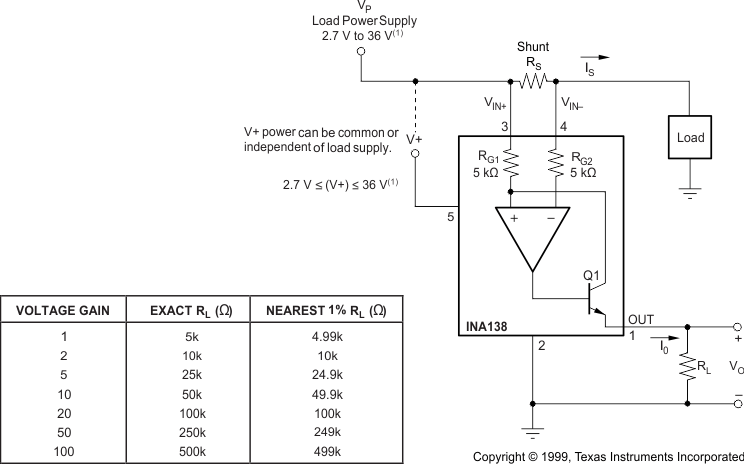ZHCSFO2E December 1999 – December 2017 INA138 , INA168
PRODUCTION DATA.
- 1 特性
- 2 应用
- 3 说明
- 4 修订历史记录
- 5 Pin Configuration and Functions
- 6 Specifications
- 7 Detailed Description
-
8 Application and Implementation
- 8.1 Application Information
- 8.2 Typical Applications
- 9 Power Supply Recommendations
- 10Layout
- 11器件和文档支持
- 12机械、封装和可订购信息
8.1.1 Operation
Figure 9 illustrates the basic circuit diagram for both the INA138 and INA168 devices. Load current IS is drawn from supply VS through shunt resistor RS. The voltage drop in shunt resistor VS is forced across RG1 by the internal op amp, causing current to flow into the collector of Q1. External resistor RL converts the output current to a voltage, VOUT, at the OUT pin. The transfer function for the INA138 device is:
where gm = 200 µA/V.
In the circuit of Figure 9, the input voltage, (VIN+ – VIN–), is equal to IS × RS and the output voltage, VOUT, is equal to IO × RL. The transconductance, gm, of the INA138 device is 200 µA/V. The complete transfer function for the current measurement amplifier in this application is:
The maximum differential input voltage for accurate measurements is 0.5 V, which produces a 100-µA output current. A differential input voltage of up to 2 V will not cause damage. Differential measurements (pins 3 and 4) must be unipolar with a more-positive voltage applied to pin 3. If a more-negative voltage is applied to pin 3, the output current, IO, will be zero, but it will not cause damage.
